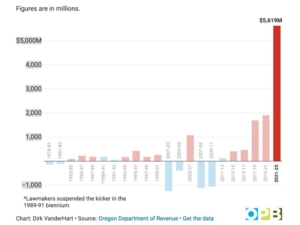
Long-Term Funding Needs Prompt Lawmakers to Ponder Future Kicker Changes
Oregon personal income taxpayers have a $5.61 billion incentive to file their tax returns early next year to receive their kicker refunds. Oregon’s state economists have less to cheer about.
Kicker refunds occur when biennial state revenue collections exceed official projections by more than 2 percent. All revenue above the projection is returned to personal income taxpayers through their tax returns.
 The $5.61 billion kicker refund is the largest in state history and three times larger than the previous record-setting refund just two years ago. The current record-setting kicker is the fifth biennium in a row when official revenue projections have been sharply exceeded, triggering ever-larger kicker refunds.
The $5.61 billion kicker refund is the largest in state history and three times larger than the previous record-setting refund just two years ago. The current record-setting kicker is the fifth biennium in a row when official revenue projections have been sharply exceeded, triggering ever-larger kicker refunds.
State economists are responsible for making the official revenue projection that legislators rely on to approve biennial budgets. The last time tax collections failed to reach official projections was the 2009-2011 biennium, which followed on the heels of a serious recession. The 2021-2023 official revenue projection followed the Covid pandemic and underestimated how rapidly and solidly the U.S. and Oregon economies would rebound.
An ‘Aggressive’ Revenue Outlook
 State Economist Mark McMullen says he was determined to project revenues that would avoid a kicker refund in the 2021-2023 biennium. “The kicker law dictates that we stick our necks out with an aggressive revenue outlook,” McMullen wrote in the forecast, “exposing us to the risk of a large budget shortfall should growth stall.”
State Economist Mark McMullen says he was determined to project revenues that would avoid a kicker refund in the 2021-2023 biennium. “The kicker law dictates that we stick our necks out with an aggressive revenue outlook,” McMullen wrote in the forecast, “exposing us to the risk of a large budget shortfall should growth stall.”
His state economist colleague, Josh Lerner, gave an interview in early 2023 predicting a mild recession in Oregon as early as the summer. “Our job is to do 10-year forecasts for the population, the economy and then the tax revenue that we expect to see,” Lerner said. “The evolution in the economy in the last 18 months was such that, by this fall, it looked like a recession was more likely than not because inflation hadn’t slowed at all.”
McMullen and Lerner, along with their outside economist advisers, didn’t foresee the state revenue impact of surging wages, higher interest earnings, huge business profits and nervous investors cashing out massive stock market earnings.
Advocates seeking state funding for homelessness, addiction treatment and K-12 schools view the situation less charitably. They see billions of dollars in tax revenue needlessly slip through the state’s fingers.
Oregon’s revenue projections for the last five biennia have been low, triggering big-time kicker refunds. One critic of the state economist suggests projections were low-balled on purpose.
 Chronic ‘Inaccurate Forecasting’
Chronic ‘Inaccurate Forecasting’
Service Employees International Union Local 503 research director Daniel Morris put that sentiment into words delivered to Governor Kotek. “Oregon’s inaccurate revenue forecasting costs billions needed for critical public services.” Morris wrote that Oregon’s revenue projections “are less accurate than most other states 75 percent of the time, and particularly so since 2014,” when McMullen was appointed state economist.
“Forecast errors should be expected, but consistently underestimating revenue is evidence of systematic biases and inaccurate assumptions,” Morris explained. “This has a real impact on the legislative and budget process and ultimately harms Oregonians and the services they rely on from the state.” He went so far to accuse Oregon’s economists of intentionally “low-balling” projections.
Lucy Dadayan, who researches state tax revenue projections for the Urban Institute, agreed to an OPB request to assess and comment on Oregon’s revenue estimates. While Oregon has had larger errors than most other states over the last decade, Dadayan said, it’s not remotely alone. “It’s becoming increasingly difficult for revenue forecasters around the nation,” she added. “In general, forecasting errors are becoming larger.”
Dadayan expressed sympathy for McMullen’s position trying to estimate revenue proceeds from a progressive personal income tax, which can be extremely volatile and subject to unpredictable national economic swings, such as what’s occurred in the post-pandemic period.
“It makes us depend more heavily on high-income households,” McMullen says. “And high-income households are the ones with these volatile income streams.”
 Swiss Alps Effect
Swiss Alps Effect
Former Senator Mark Hass, who chaired Senate Finance and Revenue, compared Oregon’s tax structure to the Swiss Alps, with sharp revenue peaks and deep revenue valleys.
“We’ve got a tax code that brings in too much in the good times and not enough in the bad times,” said Hass told OPB. “That’s really the inherent problem here. The kicker is symptomatic of that problem.”
Biennial Budgeting
Oregon is one of 16 states that operates with a two-year budget. “Divining what economic tricks or treats lie in store more than 700 days into the future verges on impossible,” McMullen says. “The potential for error grows exponentially.”
Given the volatility of an income tax revenue system, the 2 percent margin of error may be too slim to use as the basis of a kicker refund. That said, the revenue forecast for 2021-2023 was off by 25 percent. The $5.6 billion overage, if not returned to taxpayers as kicker refunds, could have increased biennial General Fund spending from $25.4 billion to $31 billion.
The $5.6 billion kicker refund roughly equaled what lawmakers budgeted in 2021-2023 General Fund outlays for Oregon universities and the Oregon Health Authority. The biennial General Fund allocation for K-12 schools totaled $7.98 billion.
Kicker History
The 1979 legislature adopted the kicker, which initially applied to both individual and corporate taxpayers. Oregon voters put the kicker in the state Constitution in 2000. In the first two biennia after its passage, the state suffered revenue shortfalls and no kicker refunds were issued. The first year Oregon taxpayers received a kicker refund was 1985. It came in the form of a check.
Lawmakers voted to suspend the kicker refund that would have gone back to taxpayers in 1991. Refunds didn’t kick in again until 1995. Revenue exceeding projections jumped to more than $1.6 billion in each of the last two biennia before bursting to $5.619 billion in the 2021-2023 biennium.
Former state economist Tom Potiowsky told OPB, “No other state has a law like the kicker, and it causes more disruption than I think the intent, which was to have control over spending by the state. The volatility of our revenue sources make it really, really tough.”
When Paul Warner, another former state economist, retired, the legislature adopted a resolution describing the job as “the least enviable in all of state government.”
Kicker Changes
Even though kicker refund reform has become like a third-rail in Oregon politics, there is a discussion among legislative Democrats of potential changes. The simplest would be to raise the margin of error from 2 percent to 5 or 10 percent.
 One idea drawing attention would carve out highly volatile capital gains tax revenue from the General Fund, removing it from kicker refund calculations. Caitlin Baggott Davis, CEO of North Star Civic Foundation, a Portland think tank, has quietly pushed the idea as a tweak.
One idea drawing attention would carve out highly volatile capital gains tax revenue from the General Fund, removing it from kicker refund calculations. Caitlin Baggott Davis, CEO of North Star Civic Foundation, a Portland think tank, has quietly pushed the idea as a tweak.
Tweak or not, it is an open question whether the legislature can enact any change without a vote of the people. Given the fraught politics of a kicker change, the topic isn’t expected to arise in the short 2024 legislative session that begins in February.
Meanwhile, McMullen said in his most recent economic report released earlier this month that revenues in the 2024-2025 biennium exceed projections and another kicker refund could be in the offing.
https://www.opb.org/article/2023/12/15/oregon-kicker-law-record-tax-spending/




